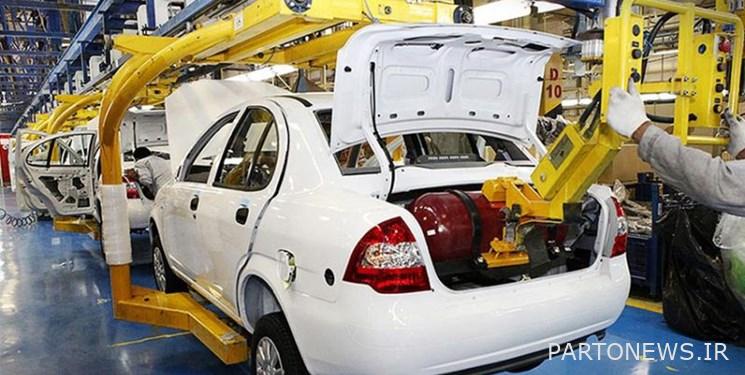National fuel -7 | The latest status of the CNG car combustion scheme / the first light for the production of dual-fuel vehicles has been clarified

According to the economic correspondent of Fars News Agency, the existence of abundant natural gas resources in the country has made the development of cheap CNG compressed natural gas fuel in the car fuel basket become one of the main priorities of the 13th government Ministry of Oil. Earlier, the Supreme Energy Council in its document “Energy supply of the country’s transportation sector to the horizon of 1420” had emphasized on doubling the consumption of CNG in cars up to the horizon of 1420.
In the government of prudence and hope, although support for the CNG industry was sidelined for a long time, but after the events of October 1998, measures to double-burn cars were on the agenda, and in a December 1398 resolution of the Economic Council, support for the CNG industry was emphasized.
* The latest status of the progress of the Economic Council plan for CNG burning of cars
Accordingly, according to the resolution of the Economic Council, the request of the Ministry of Oil of the Twelfth Government to support the production and conversion of factories and workshops of 1,464,000 taxis, vans (taxis), vans (light and heavy) and personal gasoline passengers to CNG burners under ceiling 563 $ 1,780,000 was approved and 1,464,000 vehicles were to be converted from single-burner to CNG-burning. According to the decree, this conversion is done “for free” (Table 1).
Table 1- Details of the decision of the Economic Council in December 1998
Of course, this resolution of the Economic Council was changed later in June 1400, and accordingly, a new plan was proposed for the conversion / production of 1,206,000 dual-fuel vehicles (Table 2).
In other words, due to the lack of public acceptance of dual-burning cars, the number approved by the Economic Council was reduced to 220,000 cars, and instead part of the investment was directed to the construction of stations.
Table 2: Details of the resolution approved by the Economic Council in June 1400
Thus, if any of the decrees of “D98” or “Khordad 1400” are used as a basis, by now about “one million” or “500 thousand” cars should have been dual-fuel, respectively, but now less than 200 thousand cars are under the decree of the council. Dual economies are burned.
Jalil Salari, CEO of the National Company for Refining and Distribution of Petroleum Products, referring to the progress of the dual-burn car plan Says“In the Ministry of Oil, in order to pursue the goal of replacing cyanide (compressed natural gas) with gasoline, we have succeeded in gassing about 150,000 public vehicles through the approval of the Economic Council, and today 6 contractors are working to convert these gaseous vehicles and 300 “The workshop is active.”
He continued: “Through the construction of industrial supply stations, 28 million cubic meters of this fuel has been distributed daily in the country, of which 20 million cubic meters are consumed daily.”
The explanations of the CEO of the Refining and Distribution Company about the rate of dual-burning cars under the decision of the Economic Council indicate that 80% of the program is behind the plan of D98 and 60% of the program is behind the plan of June 1400.
* 4 reasons why people do not welcome free dual-burning cars
In the previous reports of the “National Fuel” case, some reasons were mentioned for the backwardness of the dual-fuel car burning plan from the program approved by the Economic Council and the lack of public acceptance, which is summarized in Table 3 along with the solution.
Table 3
Mohammad Hossein Bagheri, CNG project manager of the National Iranian Petroleum Products Distribution Company, points to some of the reasons why the Economic Council’s decision lags behind the set targets. Is. “This quota is so large that it may have made them reluctant to double-burn their cars.”
He continued: “Another part of the reason for the lack of acceptance may be related to the price of gasoline. When this decree was announced, the price of gasoline was 1,500 Tomans and gas was 450 Tomans, and this price difference was significant for the people, but after the increase in the price of gasoline, now with this price inflation, someone else bought gasoline of 1,500 Tomans. “It does not feel.”
* The Ministry of Oil turned on the first light for the production of CNG-burning car factories
Existing solutions to support the CNG industry are not limited to Table 3, and the Ministry of Petroleum of the 13th government can help increase the share of CNG in the fuel basket by adopting some other policies. One of these policies is the production of CNG vehicles by automakers. At present, all dual-fuel vehicles under the Economic Council have been converted into workshops, not factories.
Simply put, under this policy, the Ministry of Petroleum, under a contract with automakers, pays them the cost of double-burning cars, and they also produce CNG-burning cars in their factories. But these cars are sold to people at the price of similar single-burner cars. Thus, according to the workshop conversion model, in this model, CNG burning of cars is done for people for free.
Although the decision of the Economic Council, along with the conversion of a workshop into the production of CNG-burning car factories, was emphasized, this measure was not taken seriously in the Twelfth Government. But unlike the previous government, the 13th government’s Ministry of Oil now seems to focus on producing dual-fuel car factories.
This week, the first production contract for dual-fuel car factories was signed between the National Petroleum Products Distribution Company and Iran Khodro Company under the approval of the Economic Council. According to this cooperation agreement, 45,000 gas-powered vehicles will be produced in Iran Khodro Company, of which 40,000 will be taxis and 5,000 will be vans.
The equivalent of the payment of the Ministry of Oil to the automaker will be $ 505 per production of each dual-fuel van and $ 425 per production of each dual-fuel taxi, which is also based on the 4th and 5th generations.
Of course, the increase in the share of CNG in the car fuel basket should not be limited to a single factory production contract, and this good work should be continued by the National Refining and Distribution Company. In addition to the production of dual-fuel car factories, it is necessary to focus on turning the workshop.
End of message / b
You can edit this post
Suggest this for the front page
.

